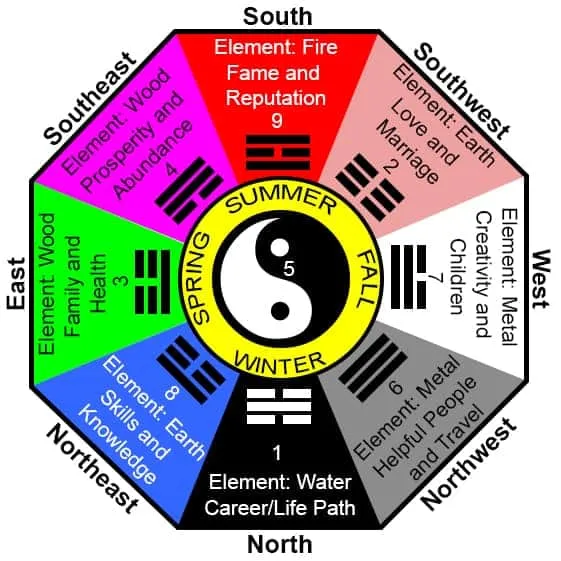I’ve encountered countless individuals who are very confused on how to apply Feng Shui. They asked me why doing one thing is auspicious according to this article, but bad according to another article.
No doubt, when you delve into Feng Shui without understanding the fundamentals, you ought to be confused. That’s because practicing Feng Shui is far from simple. Multiple factors need to be considered simultaneously, which is why there is NO blanket rule that applies in all situations.
Further, there’s just too many conflicting information and misconceptions out there. Heck, I myself was confused when I started learning Feng Shui.
This article gives you the basic Feng Shui principles and the fundamentals behind it, which is especially helpful if you’re new to Feng Shui. If there are certain Feng Shui rules that you didn’t understand, they will begin to make more sense. My goal here is to give you enough information so you can search intelligently in case you want to learn more about a specific Feng Shui topic.
Let’s begin.
Getting One Feng Shui Rule Right does NOT Bring Good Feng Shui
All too often, I get questions like: “Can this aquarium setup bring good Feng Shui” or “can this bed setup improve my relationships”?
No, Feng Shui doesn’t work like that. If it does, I would agree to statements claiming “Feng Shui works like magic”.
Here’s one key principle that you should understand: to Feng Shui your house, you need to look at the whole house and its surroundings. The surrounding Feng Shui is where the Form School comes in.
Form School: Roads, Rivers, Mountains, Objects, and Structures
Whenever you read about objects with certain shapes outside of the house (sometimes inside the house), they’re likely talking about the Form School of Feng Shui. (There is another aspect of shapes that relates to the Five Elements, which I’ll discuss later).
By Forms, I’m talking about objects and structures that include, but not limited to, electric poles in front of the front door, a building’s corner that’s “cuts” through to your house, and tall buildings that surround your home.Forms also applies to mountain ranges, how a river flows and its shape, and how a road is shaped. For instance, people are keen to avoid houses at the end of a road that’s shaped like a knife. On other instances, a Feng Shui master might recommend that you buy a house because the front of that house faces a layered mountain range (with other considerations).

Forms also include those that are inside the house. This is why you’ll read about “avoiding sharp corners”, poison arrows, and even avoiding cacti at home because its thorns may cause discomfort to some (similar to other sharp objects). However, please take note that those forms bring little negative energy, if any, when compared to the forms outside of the home.
Like all things Feng Shui, having bad forms do NOT, by default, give you bad Feng Shui. The object’s size, distance, and other immediate surroundings should all be considered.
Compass School: Directions and Compass Measurements
The Compass School is about the eight cardinal directions and is absolutely essential when practicing Feng Shui. This is where Feng Shui gets confusing because there are multiple schools here. Most of them practice Feng Shui differently and sometimes, practitioners disagree with other practices.
It is safe to assume that whenever a Luo Pan compass is used, the practitioner is applying the Compass School of Feng Shui.

Unlike the Form School, the Compass School deals with Qi, which cannot be seen. This is the main reason why there are multiple schools.
The Bagua Map is the Most Common Practice in Classical Feng Shui
Below is an image of the Bagua map:

As you can see, each quadrant has an element (Earth, Water, Fire, Metal, and Wood) and an aspect of our life associated with it. Many of the Classical schools of Feng Shui refer back to the Bagua in some way, although not exactly the way its shown above.
The Bagua Map in the Western or BTB School
Please note that the Bagua map used here is the same as those used in Classical Feng Shui. However, in the Western or BTB school, the compass direction is not taken into consideration. Nevertheless, I listed this practice here because it deals with Qi.
The Life Kua and Your Personal Auspicious Directions are from Eight Mansions
This Classical School of Feng Shui uses your birthday to calculate your life Kua number to determine your personal auspicious and inauspicious directions. The Kua number ranges from 1-4 and 6-9, just like how there are a total of eight directions. When practicing this school, many people forget that the house also has its Kua based on its sitting and facing direction.
Natal Chart of a House, Colored “Stars” and Annual Afflictions are from Flying Stars
Flying Stars is also one of the most popular Classical School of Feng Shui. In its essence, it uses space and time to determine if an area is auspicious or not in a certain time period. You’ll typically read about “star” names with a number and color in its name, such as Five Yellow misfortune star or the Eight White prosperity star. You’ll also see a natal chart consisting of a set of numbers like the one below:

The natal chart is determined by the sitting and facing direction of the house and the year when the house was built. Among these numbers are the annual “stars” that changes each year.
The Five Elements: Colors, Shapes, and Material
Whenever you read about Earth, Water, Fire, Metal, and Wood, they are referring to the Five Elements. In essence, this theory explains how the ancient Chinese view the relationship between natural objects in this world. All the schools above have the Feng Shui Five Elements theory embedded in them.
In my Feng Shui Five Elements guide, I noted:
The Five Elements are used in Form School based on the object’s color, shape, and material. Similarly, the Five Elements are used in Compass School based on the eight cardinal directions, where each direction is correlated with one of the Five Elements.
Use that guide to see what color, shape, and materials are associated with each element, and what strengthens, destructs, and weakens those elements.

Feng Shui practitioners typically use the color, shape, and/or material of an object to strengthen or weaken the Qi of an area. For instance, in the Bagua map, North is associated with water. To weaken this area, one would place an object with the colors, shapes, or material associated with wood.
Some practitioners even assign an element to our home appliances, such as refrigerators or dish washing machines. But then, confusions arise because electronics are associated with fire, whereas the water inside those appliances is what it is – water.
What element is the appliance then? Fire, water, or both? Don’t the two elements conflict? My suggestion? Stick with the basics and don’t go overboard on this.
Avoiding the Inauspicious is Priority
This question about bed placement is especially common: “If I place my bed in a positive direction, my bed will face the door (which should be avoided). But if I avoid the door, the bed is in an inauspicious direction. What should I do?” This article addresses questions about bed placement just like those.
https://fengshuinexus.com/feng-shui-bedroom/feng-shui-bed-placement-rules-conflict-use/
The general rule of thumb is, you should avoid the inauspicious as priority. For instance, you should avoid a home that sits right at the end of a T-junction as priority (assuming that T-junction is bad Feng Shui because.)
https://fengshuinexus.com/feng-shui-home/feng-shui-houses-t-intersection/
One master described mixing auspicious and inauspicious Qi together as mixing polluted water with clean water. Just a bit of polluted water will make the clean water undrinkable.
The main takeaway here is this: good Feng Shui will NOT cancel the bad. Avoiding the inauspicious and having neutral Feng Shui is a win in many situations.
Consider the Historical Context
Feng Shui was developed in ancient China thousands of years ago. Therefore, many of its rules should be re-evaluated based on its historical context.
For instance, you might hear that the front door facing the kitchen is bad Feng Shui. However, I think that rule is outdated because our kitchens today are significantly different than the ones in ancient China. The same applies to restroom Feng Shui where some of the rules are outdated.

Further, you might hear that houses that sits North and faces South are preferrable (similar to the orientation of the Forbidden Palace in Beijing). However, that concept is based on more practical reasons, which involve seasonal wind directions in China and the preferrable restroom location based on the four celestial animals in Feng Shui.
Details Tell You Exceptions to Feng Shui Rules
Simply put, Feng Shui is not that simple or straightforward. A Feng Shui rule is NOT definite because many factors have to be considered simultaneously and comprehensively.
One example is assuming it is bad Feng Shui if your front door opens to a set of stairs. To make that statement true, you need to factor in details such as the distance between the stairs and the front door, and how frequent the front door is used.
Another example is finding your home’s facing direction. Your front door’s direction is NOT your home’s facing direction by default (for most houses it is because the both coincides). Further, contrary to popular belief, not all T-junctions are bad Feng Shui by default.
Conclusion
This list of basic principles is for beginners and is not meant to be exhaustive. It does not cover all the different practices in the Compass School that are out there. Instead, this article should guide you to search intelligently for a specific knowledge you’re interested in.
If you’re tired of learning bits and pieces from various websites, I suggest that you take beginner Feng Shui classes. Or, you can directly ask questions and engage with Feng Shui masters here.
What was your journey like when you started learning Feng Shui? Were you as confused (as I was)? Share your experience with us by commenting below!
Feng Shui practitioner and blogger of Feng Shui Nexus. I’ve witnessed the efficacy of Feng Shui, astrology and divination. Here, I share my knowledge and experiences with you to get you closer to your goals and dreams. Subscribe to get email updates or follow us on Facebook, Twitter, and Pinterest.


so I have a question. What if you are in transition between homes and living in a bedroom in someone’s house. You can’t go changing their entire house but you can control the bedroom you are using. Is it practical to set your bedroom up with good feng shui or does the entire rest of the home being out of feng shui cancel out the perfect set up in your one room?
thanks
Hi Patrice,
Yes, you can setup your bedroom with good Feng Shui, which only you will benefit. However, if there is a negative Form facing the house, like a T-junction, then everyone’s going to get affected. The both don’t cancel out each other.
-Victor
Best, most informative article on the basics of feng shui.
Hi Victor,
How would you remediate a home with split stairs in the center of the home, but also facing the kitchen?
Hi Bonita,
I would need more information that what you just described, because distance, size, etc. all need to be considered. There could also be no issues in your setup.
-Victor
Hi Victor,
some practitioners say that the facing direction should be the auspicious direction, i.e. a person with Kua 6 has auspicious direction to West. So the house should face West.
However, some practitioners say that the house should be sitting in West and facing East, which is inauspicious direction.
So what’s your opinion about this?
Hi Dwi,
This article will help clarify: https://fengshuinexus.com/feng-shui-home/feng-shui-directions-eight-mansions-house-kua/
-Victor